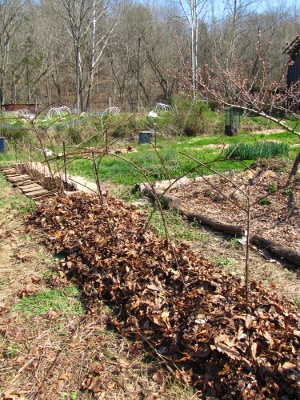
Renovating an overgrown blackberry patch

It's awfully easy to let
even thornless blackberries turn into an impenetrable jungle.
Just forget to tip
prune them one
summer, then you're unable to mow the tall weeds that pop up under
their arching canes. By fall, the row looks like a wild briar
patch.
The first step in
renovating a patch like this (or any other kind of overgrown bramble)
is to prune out the worst canes. I snip off all of the rooted
canes in the aisle and then cut the plants back to a main stem with
branches six to twelve inches long. Meanwhile, I pull or cut out
dead canes from previous years. I'm not really pruning yet, just
opening up the patch so I can get in there.
 Next, I dig out any tall
weeds that rooted within the row. Ragweed isn't a perennial, but
once plants like wingstem get a foothold in your bed, even a kill
mulch will have a
hard time holding them back. I might accidentally dig up a berry
or two in the process, but that's not a problem --- there are plenty of
brambles left.
Next, I dig out any tall
weeds that rooted within the row. Ragweed isn't a perennial, but
once plants like wingstem get a foothold in your bed, even a kill
mulch will have a
hard time holding them back. I might accidentally dig up a berry
or two in the process, but that's not a problem --- there are plenty of
brambles left.
Now that I can see what
I'm doing, it's pretty simple to prune
the blackberries using techniques I've explained previously.
After a good pruning and weeding job, I lay down a kill mulch along
side of the berries to prevent the bad weeds I might have missed from
encroaching into the planted zone. Then I top it all off with
mulch and mark a remulching and summer pruning job on my June calendar
to ensure the problem doesn't reoccur.
Luckily, brambles are
awfully forgiving of even the worst care. Even though this patch
looked like a jungle last summer, it will probably produce pretty well
for me this year (and even better next year if I manage to keep the
weeds down). Our blueberries are more daunted by weeds, and I can
see a big difference between the plants I managed to remulch last
summer and the ones that got away from me. Maybe next spring,
I'll be so on top of the perennials, everyone will be in good shape.
Want more in-depth information? Browse through our books.
Or explore more posts by date or by subject.
About us: Anna Hess and Mark Hamilton spent over a decade living self-sufficiently in the mountains of Virginia before moving north to start over from scratch in the foothills of Ohio. They've experimented with permaculture, no-till gardening, trailersteading, home-based microbusinesses and much more, writing about their adventures in both blogs and books.
Want to be notified when new comments are posted on this page? Click on the RSS button after you add a comment to subscribe to the comment feed, or simply check the box beside "email replies to me" while writing your comment.

Heath --- I tend to put them in whatever direction makes most sense from a path point of view. You don't want to try to cut through your berry patch....
If I was planning the perfect homestead, I'd align my rows with the contour so they grabbed any tiny bit of topsoil eroding down the slope. Alternatively, I might align them to run N-S if they were along a vegetable garden that I didn't want shaded. Ever-bearing red raspberry fruits are a bit prone to molding in our humid summers, so I might align those E-W to maximize sun.
But none of our berries seem to mind much what I do with them --- they are definitely dogs, not cats, of the plant world.
For some reason, I thought a N-S alignment meant maximum sun exposure? As in, the row is running N-S, so the sun rises in the east and sets in the west, making it hit all sides of your row plants? Maybe I'm just confused.
~ Mitsy